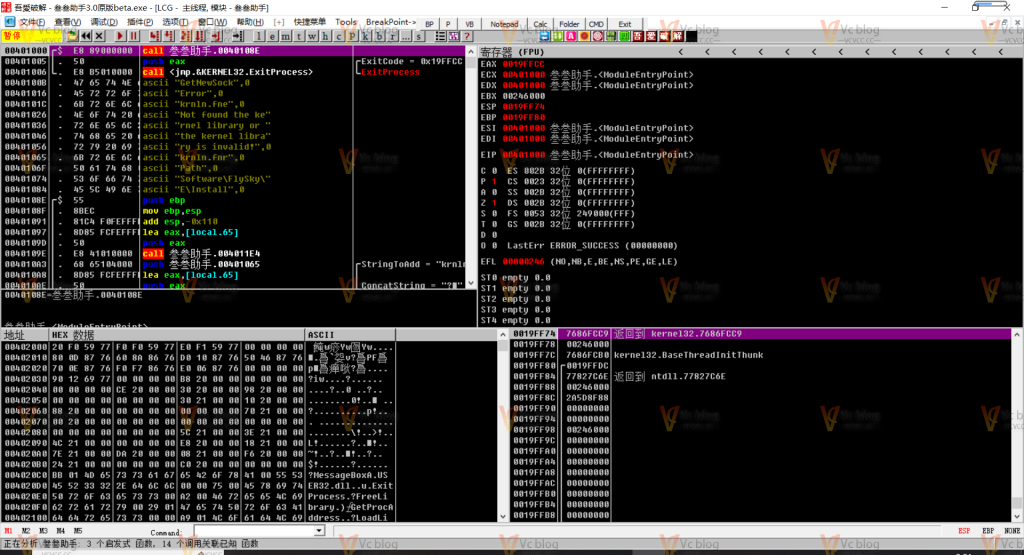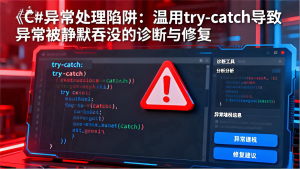在Python开发中,异常处理是构建健壮应用程序的关键技能。很多开发者在面对复杂的错误场景时,往往陷入要么过度捕获异常导致问题被掩盖,要么异常处理不足导致程序崩溃的两难境地。本文将深入解析Python异常处理的各个方面,帮助你构建完善的错误处理机制。
![图片[1]-Python异常处理完全指南:从基础try-except到自定义异常体系](https://blogimg.vcvcc.cc/2025/11/20251111132217930-1024x768.png?imageView2/0/format/webp/q/75)
一、基础异常处理:从入门到精通
1. 基本try-except语法与常见陷阱
基础语法:
# 基础异常捕获
try:
# 可能引发异常的代码
result = 10 / 0
print(f"结果是: {result}")
except ZeroDivisionError:
# 处理特定异常
print("错误:除数不能为零!")
# 捕获多个异常
try:
number = int("abc") # ValueError
data = [1, 2, 3]
print(data[10]) # IndexError
except (ValueError, IndexError) as e:
print(f"数据错误: {e}")
# 分别处理不同异常
try:
file = open("nonexistent.txt", "r")
content = file.read()
number = int(content)
except FileNotFoundError:
print("文件不存在")
except ValueError:
print("文件内容不是有效数字")
except Exception as e:
print(f"其他错误: {e}")
finally:
# 无论是否发生异常都会执行
print("清理操作完成")常见陷阱与解决方案:
# 陷阱1:过于宽泛的异常捕获
# 反模式
try:
do_something()
except: # 捕获所有异常,包括KeyboardInterrupt等系统异常
print("发生错误")
# 正确做法:明确指定异常类型
try:
do_something()
except (ValueError, TypeError) as e:
print(f"业务逻辑错误: {e}")
except Exception as e: # 捕获其他非系统异常
print(f"意外错误: {e}")
# 记录日志
import logging
logging.exception("操作失败")
# 陷阱2:忽略异常信息
# 反模式
try:
risky_operation()
except Exception:
pass # 静默忽略,难以调试
# 正确做法:记录异常信息
try:
risky_operation()
except Exception as e:
print(f"操作失败: {e}")
# 或者记录到日志
logging.error(f"操作失败: {e}", exc_info=True)
# 陷阱3:不完整的清理
# 反模式
try:
file = open("data.txt", "w")
file.write(some_data)
# 如果这里发生异常,文件不会关闭
process_data()
except Exception as e:
print(f"错误: {e}")
# 正确做法:使用with语句或finally
# 方案1:使用with语句(推荐)
try:
with open("data.txt", "w") as file:
file.write(some_data)
process_data() # 即使这里异常,文件也会正确关闭
except Exception as e:
print(f"错误: {e}")
# 方案2:使用finally确保清理
file = None
try:
file = open("data.txt", "w")
file.write(some_data)
process_data()
except Exception as e:
print(f"错误: {e}")
finally:
if file:
file.close()2. 异常对象与异常信息获取
def detailed_exception_handling():
"""详细的异常信息处理"""
try:
# 模拟多种可能异常的场景
data = {"users": ["Alice", "Bob"]}
# 场景1:键错误
# print(data["nonexistent_key"])
# 场景2:类型错误
# result = "hello" + 123
# 场景3:索引错误
print(data["users"][5])
except KeyError as e:
print(f"键错误: 缺少键 {e}")
print(f"可用键: {list(data.keys())}")
except TypeError as e:
print(f"类型错误: {e}")
print("请检查数据类型是否匹配")
except IndexError as e:
print(f"索引错误: {e}")
print(f"列表长度: {len(data['users'])}")
except Exception as e:
# 获取异常的详细信息
print(f"异常类型: {type(e).__name__}")
print(f"异常信息: {e}")
print(f"异常参数: {e.args}")
# 获取调用栈信息(调试用)
import traceback
print("调用栈:")
traceback.print_exc()
# 测试异常处理
detailed_exception_handling()
# 异常对象的其他有用属性
try:
risky_call()
except Exception as e:
# 获取异常的字符串表示
error_str = str(e)
# 获取异常的类名
exception_name = e.__class__.__name__
# 使用traceback模块获取详细信息
import traceback
full_traceback = traceback.format_exc()
print(f"错误: {error_str}")
print(f"异常类型: {exception_name}")
print("完整跟踪:")
print(full_traceback)二、自定义异常体系设计
1. 基础自定义异常
class AppError(Exception):
"""应用程序基础异常"""
def __init__(self, message, error_code=None, details=None):
self.message = message
self.error_code = error_code
self.details = details or {}
super().__init__(self.message)
def __str__(self):
if self.error_code:
return f"[{self.error_code}] {self.message}"
return self.message
def to_dict(self):
"""转换为字典,用于API响应等场景"""
return {
"error": self.message,
"code": self.error_code,
"details": self.details
}
# 具体的业务异常
class ValidationError(AppError):
"""数据验证错误"""
def __init__(self, message, field=None, value=None):
details = {}
if field:
details["field"] = field
if value:
details["value"] = value
super().__init__(
message=message,
error_code="VALIDATION_ERROR",
details=details
)
class DatabaseError(AppError):
"""数据库操作错误"""
def __init__(self, message, operation=None, table=None):
details = {}
if operation:
details["operation"] = operation
if table:
details["table"] = table
super().__init__(
message=message,
error_code="DATABASE_ERROR",
details=details
)
class NetworkError(AppError):
"""网络通信错误"""
def __init__(self, message, url=None, status_code=None):
details = {}
if url:
details["url"] = url
if status_code:
details["status_code"] = status_code
super().__init__(
message=message,
error_code="NETWORK_ERROR",
details=details
)
# 使用自定义异常
def validate_user_age(age):
if not isinstance(age, int):
raise ValidationError(
"年龄必须是整数",
field="age",
value=age
)
if age < 0:
raise ValidationError(
"年龄不能为负数",
field="age",
value=age
)
if age > 150:
raise ValidationError(
"年龄无效",
field="age",
value=age
)
return True
def create_user_profile(user_data):
"""创建用户档案"""
try:
# 验证数据
validate_user_age(user_data.get("age"))
# 模拟数据库操作
if user_data.get("name") == "admin":
raise DatabaseError(
"用户名已存在",
operation="INSERT",
table="users"
)
print("用户创建成功")
return {"status": "success", "user_id": 123}
except ValidationError as e:
print(f"数据验证失败: {e}")
return e.to_dict()
except DatabaseError as e:
print(f"数据库操作失败: {e}")
return e.to_dict()
# 测试自定义异常
test_cases = [
{"name": "Alice", "age": 25}, # 成功
{"name": "Bob", "age": -5}, # 验证错误
{"name": "admin", "age": 30}, # 数据库错误
{"name": "Charlie", "age": "old"}, # 类型错误
]
for user_data in test_cases:
print(f"\n处理用户: {user_data}")
result = create_user_profile(user_data)
print(f"结果: {result}")2. 层次化异常体系
class PaymentSystemError(AppError):
"""支付系统基础异常"""
pass
class PaymentValidationError(PaymentSystemError):
"""支付验证错误"""
def __init__(self, message, field=None, payment_method=None):
details = {"payment_method": payment_method}
if field:
details["field"] = field
super().__init__(
message=message,
error_code="PAYMENT_VALIDATION_ERROR",
details=details
)
class PaymentProcessingError(PaymentSystemError):
"""支付处理错误"""
def __init__(self, message, transaction_id=None, reason=None):
details = {}
if transaction_id:
details["transaction_id"] = transaction_id
if reason:
details["reason"] = reason
super().__init__(
message=message,
error_code="PAYMENT_PROCESSING_ERROR",
details=details
)
class InsufficientFundsError(PaymentProcessingError):
"""余额不足错误"""
def __init__(self, amount, current_balance, transaction_id=None):
message = f"余额不足: 需要{amount},当前余额{current_balance}"
details = {
"required_amount": amount,
"current_balance": current_balance,
"shortfall": amount - current_balance
}
super().__init__(
message=message,
transaction_id=transaction_id,
reason="insufficient_funds"
)
class CardDeclinedError(PaymentProcessingError):
"""卡片被拒绝错误"""
def __init__(self, reason_code, transaction_id=None):
reason_messages = {
"expired": "卡片已过期",
"stolen": "卡片挂失",
"limit_exceeded": "超过信用额度"
}
message = f"卡片被拒绝: {reason_messages.get(reason_code, '未知原因')}"
super().__init__(
message=message,
transaction_id=transaction_id,
reason=reason_code
)
# 使用层次化异常
def process_payment(amount, card_info, user_balance):
"""处理支付"""
try:
# 验证支付信息
if not card_info.get("card_number"):
raise PaymentValidationError(
"卡号不能为空",
field="card_number",
payment_method="credit_card"
)
# 检查余额
if user_balance < amount:
raise InsufficientFundsError(
amount=amount,
current_balance=user_balance,
transaction_id="TXN_12345"
)
# 模拟卡片验证
if card_info.get("status") == "expired":
raise CardDeclinedError(
reason_code="expired",
transaction_id="TXN_12345"
)
print("支付处理成功")
return {"status": "success", "transaction_id": "TXN_12345"}
except PaymentValidationError as e:
print(f"支付验证失败: {e}")
return e.to_dict()
except InsufficientFundsError as e:
print(f"余额不足: {e}")
return e.to_dict()
except CardDeclinedError as e:
print(f"卡片被拒绝: {e}")
return e.to_dict()
except PaymentSystemError as e:
print(f"支付系统错误: {e}")
return e.to_dict()
# 测试支付处理
payment_cases = [
{"amount": 100, "card_info": {"card_number": "1234"}, "balance": 200},
{"amount": 100, "card_info": {"card_number": ""}, "balance": 200},
{"amount": 300, "card_info": {"card_number": "1234"}, "balance": 200},
{"amount": 100, "card_info": {"card_number": "1234", "status": "expired"}, "balance": 200},
]
for case in payment_cases:
print(f"\n处理支付: 金额{case['amount']}, 余额{case['balance']}")
result = process_payment(
case["amount"],
case["card_info"],
case["balance"]
)
print(f"结果: {result}")三、高级异常处理技巧
1. 异常链与上下文保留
def process_data_file(filename):
"""处理数据文件 - 演示异常链"""
try:
with open(filename, 'r') as file:
data = file.read()
numbers = [int(line.strip()) for line in data.split('\n') if line.strip()]
return sum(numbers) / len(numbers)
except FileNotFoundError as e:
# 保留原始异常信息,添加上下文
raise AppError(
f"无法处理文件 {filename}",
error_code="FILE_PROCESSING_ERROR",
details={"filename": filename}
) from e
except (ValueError, ZeroDivisionError) as e:
# 转换异常类型,保留原始信息
raise AppError(
"文件内容格式错误",
error_code="DATA_FORMAT_ERROR",
details={"filename": filename, "original_error": str(e)}
) from e
def analyze_dataset(filenames):
"""分析数据集 - 多层异常处理"""
results = []
for filename in filenames:
try:
avg = process_data_file(filename)
results.append({"filename": filename, "average": avg})
except AppError as e:
print(f"处理文件 {filename} 时发生错误: {e}")
# 查看异常链
if e.__cause__:
print(f"根本原因: {e.__cause__}")
# 记录错误但继续处理其他文件
results.append({"filename": filename, "error": e.message})
continue
return results
# 测试异常链
test_files = ["data1.txt", "nonexistent.txt", "data2.txt", "invalid_data.txt"]
# 先创建测试文件
with open("data1.txt", "w") as f:
f.write("10\n20\n30\n")
with open("data2.txt", "w") as f:
f.write("5\n15\n25\n")
with open("invalid_data.txt", "w") as f:
f.write("abc\ndef\n") # 无效数字
print("分析数据集:")
results = analyze_dataset(test_files)
print("\n分析结果:")
for result in results:
if "average" in result:
print(f"{result['filename']}: 平均值 = {result['average']}")
else:
print(f"{result['filename']}: 错误 = {result['error']}")2. 上下文管理器与异常处理
class DatabaseTransaction:
"""数据库事务上下文管理器"""
def __init__(self, db_connection):
self.db_connection = db_connection
self.transaction_active = False
def __enter__(self):
self.transaction_active = True
print("开始数据库事务")
return self
def __exit__(self, exc_type, exc_val, exc_tb):
self.transaction_active = False
if exc_type is None:
# 没有异常,提交事务
print("提交事务")
return True
else:
# 有异常,回滚事务
print(f"回滚事务,原因: {exc_val}")
# 可以根据异常类型决定是否重新抛出
if isinstance(exc_val, (ValueError, TypeError)):
print("业务逻辑错误,已处理")
return True # 抑制异常
else:
print("系统错误,需要重新抛出")
return False # 重新抛出异常
def execute_query(self, query):
"""执行查询"""
if not self.transaction_active:
raise RuntimeError("不在事务中")
print(f"执行查询: {query}")
return f"结果: {query}"
# 使用事务上下文管理器
def process_business_operation():
"""处理业务操作"""
db_connection = "模拟数据库连接"
try:
with DatabaseTransaction(db_connection) as transaction:
transaction.execute_query("INSERT INTO users VALUES ('Alice')")
transaction.execute_query("UPDATE accounts SET balance = 100")
# 模拟业务错误
raise ValueError("业务规则验证失败")
transaction.execute_query("COMMIT")
except Exception as e:
print(f"业务操作失败: {e}")
def process_critical_operation():
"""处理关键操作"""
db_connection = "模拟数据库连接"
try:
with DatabaseTransaction(db_connection) as transaction:
transaction.execute_query("INSERT INTO logs VALUES ('start')")
# 模拟系统错误
raise MemoryError("内存不足")
transaction.execute_query("INSERT INTO logs VALUES ('end')")
except Exception as e:
print(f"关键操作失败: {e}")
# 测试不同的异常处理策略
print("=== 测试业务操作 ===")
process_business_operation()
print("\n=== 测试关键操作 ===")
process_critical_operation()3. 重试机制与断路器模式
import time
import random
from functools import wraps
class RetryableError(AppError):
"""可重试的错误"""
pass
class CircuitBreaker:
"""断路器模式"""
def __init__(self, failure_threshold=3, recovery_timeout=10):
self.failure_threshold = failure_threshold
self.recovery_timeout = recovery_timeout
self.failures = 0
self.last_failure_time = None
self.state = "CLOSED" # CLOSED, OPEN, HALF_OPEN
def can_execute(self):
"""检查是否允许执行"""
if self.state == "OPEN":
# 检查是否超过恢复超时
if (time.time() - self.last_failure_time) > self.recovery_timeout:
self.state = "HALF_OPEN"
return True
return False
return True
def record_success(self):
"""记录成功"""
self.failures = 0
self.state = "CLOSED"
def record_failure(self):
"""记录失败"""
self.failures += 1
self.last_failure_time = time.time()
if self.failures >= self.failure_threshold:
self.state = "OPEN"
def retry_on_failure(max_retries=3, delay=1, backoff=2, exceptions=(Exception,)):
"""重试装饰器"""
def decorator(func):
@wraps(func)
def wrapper(*args, **kwargs):
retries = 0
current_delay = delay
while retries <= max_retries:
try:
return func(*args, **kwargs)
except exceptions as e:
retries += 1
if retries > max_retries:
print(f"达到最大重试次数 {max_retries},最终失败: {e}")
raise
print(f"第 {retries} 次尝试失败: {e},{current_delay}秒后重试")
time.sleep(current_delay)
current_delay *= backoff # 指数退避
return None
return wrapper
return decorator
def circuit_breaker_protected(circuit_breaker):
"""断路器保护装饰器"""
def decorator(func):
@wraps(func)
def wrapper(*args, **kwargs):
if not circuit_breaker.can_execute():
raise RetryableError("断路器已打开,拒绝执行")
try:
result = func(*args, **kwargs)
circuit_breaker.record_success()
return result
except Exception as e:
circuit_breaker.record_failure()
if isinstance(e, RetryableError):
raise RetryableError(f"受保护操作失败: {e}") from e
raise
return wrapper
return decorator
# 使用重试和断路器
@retry_on_failure(max_retries=3, delay=1, exceptions=(RetryableError,))
@circuit_breaker_protected(CircuitBreaker(failure_threshold=2, recovery_timeout=5))
def unreliable_remote_call():
"""模拟不可靠的远程调用"""
if random.random() < 0.7: # 70%概率失败
raise RetryableError("远程服务暂时不可用")
return "调用成功"
# 测试重试和断路器
print("测试重试机制和断路器:")
for i in range(10):
try:
result = unreliable_remote_call()
print(f"尝试 {i+1}: {result}")
time.sleep(0.5) # 间隔一下
except RetryableError as e:
print(f"尝试 {i+1}: 最终失败 - {e}")
time.sleep(2) # 给断路器时间恢复四、调试与日志记录
1. 结构化异常日志记录
import logging
import json
from datetime import datetime
class StructuredErrorLogger:
"""结构化错误日志记录器"""
def __init__(self, log_file="errors.json"):
self.logger = logging.getLogger("StructuredErrorLogger")
self.logger.setLevel(logging.ERROR)
# 创建JSON格式的处理器
handler = logging.FileHandler(log_file)
# 自定义JSON格式
class JSONFormatter(logging.Formatter):
def format(self, record):
log_entry = {
"timestamp": datetime.now().isoformat(),
"level": record.levelname,
"message": record.getMessage(),
"exception": getattr(record, 'exception_info', None),
"context": getattr(record, 'context', {}),
"module": record.module,
"function": record.funcName,
"line": record.lineno
}
return json.dumps(log_entry, ensure_ascii=False)
handler.setFormatter(JSONFormatter())
self.logger.addHandler(handler)
def log_error(self, error, context=None, exc_info=True):
"""记录错误"""
extra = {
'context': context or {},
'exception_info': str(error) if exc_info else None
}
self.logger.error(
f"应用程序错误: {error}",
extra=extra,
exc_info=exc_info
)
def error_handler(func):
"""错误处理装饰器"""
@wraps(func)
def wrapper(*args, **kwargs):
logger = StructuredErrorLogger()
try:
return func(*args, **kwargs)
except AppError as e:
# 业务异常,记录并返回友好错误
context = {
"function": func.__name__,
"args": str(args),
"error_code": e.error_code,
"details": e.details
}
logger.log_error(e, context=context, exc_info=False)
# 返回结构化错误响应
return e.to_dict()
except Exception as e:
# 系统异常,详细记录
context = {
"function": func.__name__,
"args": str(args),
"timestamp": datetime.now().isoformat()
}
logger.log_error(e, context=context, exc_info=True)
# 返回通用错误响应
return {
"error": "系统内部错误",
"code": "INTERNAL_ERROR",
"timestamp": context["timestamp"]
}
return wrapper
# 使用错误处理装饰器
@error_handler
def process_user_request(user_data):
"""处理用户请求"""
# 模拟业务逻辑
if not user_data.get("user_id"):
raise ValidationError("用户ID不能为空", field="user_id")
if user_data.get("action") == "dangerous":
raise Exception("危险操作被阻止")
return {"status": "success", "data": "处理完成"}
# 测试错误处理
test_requests = [
{"user_id": 123, "action": "safe"},
{"user_id": None, "action": "safe"},
{"user_id": 123, "action": "dangerous"}
]
print("处理用户请求:")
for request in test_requests:
result = process_user_request(request)
print(f"请求: {request} -> 结果: {result}")2. 调试友好的异常信息
def create_debuggable_exception(message, debug_info=None):
"""创建包含调试信息的异常"""
class DebuggableError(Exception):
def __init__(self, message, debug_info=None):
self.message = message
self.debug_info = debug_info or {}
self.timestamp = datetime.now()
super().__init__(self.message)
def __str__(self):
base_message = super().__str__()
debug_str = json.dumps(self.debug_info, indent=2, default=str)
return f"{base_message}\n调试信息:\n{debug_str}"
def to_debug_dict(self):
"""转换为调试字典"""
return {
"message": self.message,
"debug_info": self.debug_info,
"timestamp": self.timestamp.isoformat(),
"type": self.__class__.__name__
}
return DebuggableError(message, debug_info)
def debug_wrapper(func):
"""调试包装器"""
@wraps(func)
def wrapper(*args, **kwargs):
try:
return func(*args, **kwargs)
except Exception as e:
# 增强异常信息
debug_info = {
"function": func.__name__,
"args": str(args)[:100], # 限制长度
"kwargs": str(kwargs)[:100],
"local_vars": {k: str(v)[:50] for k, v in locals().items()
if not k.startswith('_') and k != 'e'},
"call_stack": [f"{f.filename}:{f.lineno} in {f.function}"
for f in inspect.stack()[1:6]] # 最近5个调用
}
raise create_debuggable_exception(str(e), debug_info) from e
return wrapper
# 使用调试包装器
@debug_wrapper
def complex_calculation(data):
"""复杂计算函数"""
result = data["a"] / data["b"] # 可能除零
processed = result + data["c"]["d"] # 可能键错误
return processed * data.get("multiplier", 1)
# 测试调试功能
test_data = [
{"a": 10, "b": 2, "c": {"d": 5}}, # 正常
{"a": 10, "b": 0, "c": {"d": 5}}, # 除零错误
{"a": 10, "b": 2, "c": {}}, # 键错误
]
for data in test_data:
try:
result = complex_calculation(data)
print(f"数据: {data} -> 结果: {result}")
except Exception as e:
print(f"数据: {data} -> 错误: {e}")
print("-" * 50)五、最佳实践总结
1. 异常处理原则检查清单
class ExceptionHandlingGuidelines:
"""异常处理指导原则"""
@staticmethod
def validate_exception_handling(code_snippet):
"""验证异常处理代码"""
warnings = []
# 检查1: 避免裸露的except
if "except:" in code_snippet and "except Exception:" not in code_snippet:
warnings.append("避免使用裸露的except语句,应该明确指定异常类型")
# 检查2: 不要静默忽略异常
if "except" in code_snippet and "pass" in code_snippet:
warnings.append("不要静默忽略异常,至少应该记录日志")
# 检查3: 检查资源清理
if "open(" in code_snippet and "with " not in code_snippet:
warnings.append("文件操作应该使用with语句确保正确关闭")
# 检查4: 避免过度捕获
if code_snippet.count("except") > 3:
warnings.append("异常捕获可能过于复杂,考虑重构")
return warnings
@staticmethod
def get_best_practices():
"""返回异常处理最佳实践"""
return {
"specificity": "捕获具体的异常类型,而不是通用的Exception",
"context": "在异常消息中包含足够的上下文信息",
"recovery": "提供有意义的错误恢复策略",
"logging": "记录异常信息用于调试和监控",
"propagation": "在适当的层级处理异常,不要过早捕获",
"custom_exceptions": "为业务逻辑定义自定义异常类型",
"resource_management": "使用上下文管理器管理资源",
"user_experience": "为用户提供友好的错误消息"
}
# 使用指导原则
code_example = """
try:
file = open("data.txt")
data = file.read()
result = int(data)
except:
pass
"""
warnings = ExceptionHandlingGuidelines.validate_exception_handling(code_example)
print("代码检查警告:")
for warning in warnings:
print(f"- {warning}")
print("\n异常处理最佳实践:")
practices = ExceptionHandlingGuidelines.get_best_practices()
for key, practice in practices.items():
print(f"- {key}: {practice}")2. 异常处理策略模板
def create_robust_function(func_name, operation_description):
"""创建健壮函数的模板"""
template = f'''
def {func_name}(*args, **kwargs):
"""
{operation_description}
异常处理策略:
- ValidationError: 输入数据验证失败
- DatabaseError: 数据库操作失败
- NetworkError: 网络通信失败
- 其他异常: 系统内部错误
"""
logger = StructuredErrorLogger()
try:
# 主要业务逻辑
result = _execute_{func_name}_core(*args, **kwargs)
return {{"status": "success", "data": result}}
except ValidationError as e:
logger.log_error(e, context={{"function": "{func_name}"}}, exc_info=False)
return e.to_dict()
except (DatabaseError, NetworkError) as e:
logger.log_error(e, context={{"function": "{func_name}"}}, exc_info=True)
return e.to_dict()
except Exception as e:
logger.log_error(e, context={{"function": "{func_name}"}}, exc_info=True)
return {{
"error": "系统内部错误",
"code": "INTERNAL_ERROR",
"request_id": "REQ_12345" # 实际中应该生成唯一ID
}}
def _execute_{func_name}_core(*args, **kwargs):
"""核心业务逻辑实现"""
# 在这里实现具体的业务逻辑
raise NotImplementedError("需要实现核心逻辑")
'''
return template
# 生成函数模板
user_creation_template = create_robust_function(
"create_user",
"创建新用户账户"
)
print("生成的函数模板:")
print(user_creation_template)总结
Python异常处理是一个多层次、系统化的工程,关键要点包括:
- 基础语法掌握:熟练使用try-except-else-finally,理解不同代码块的执行顺序
- 异常类型识别:区分业务异常和系统异常,采用不同的处理策略
- 自定义异常体系:建立层次化的异常类,提供丰富的错误上下文
- 资源管理:使用上下文管理器确保资源正确释放
- 重试与容错:实现重试机制和断路器模式提高系统韧性
- 日志与监控:结构化记录异常信息,便于调试和问题追踪
- 用户体验:为用户提供清晰友好的错误信息
通过系统化的异常处理策略,可以构建出既健壮又易于维护的Python应用程序。记住,好的异常处理不是阻止所有错误,而是优雅地处理不可避免的错误。
© 版权声明
THE END

















暂无评论内容